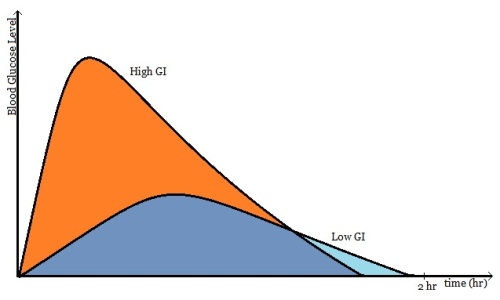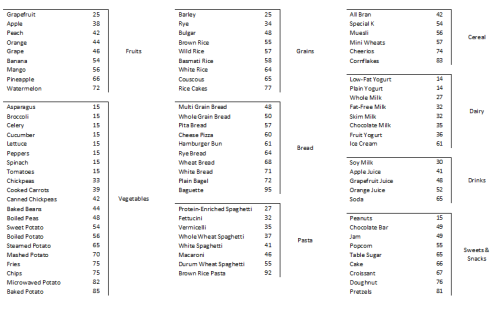Developed in the early 1980s through diabetes research at the University of Toronto, the glycemic Index is a ranking of the effect of carbohydrates on blood sugar levels. (DJ Jenkins et al. (1981).)
For those of you that are mathematically inclined, it is actually the integral of the two-hour blood glucose response curve following its ingestion. It is generally done using 50 grams of the carbohydrate and the value obtained is divided by the standard (which is usually glucose) and multiplied by 100.
In other words, carbs that breakdown quickly and release the glucose more rapidly into the bloodstream will have a high GI. Conversely, those that breakdown more slowly and release the glucose more gradually will have a low GI. Although it is not always the case, a low GI carb will require less insulin and may improve blood glucose control over the long term. (DJ Jenkins et al. (2008).)
In recent years, scientific studies have shown that individuals that followed at diet of low-GI foods over several years were at lower risk for type 2 diabetes and coronary heart disease. Although the American Diabetes Association supports the glycemic index, they warn that the total amount of carbohydrates in the food is still the most important indicator: “Based on the research, for most people with diabetes, the first tool for managing blood glucose is some type of carbohydrate counting. Balancing total carbohydrate intake with physical activity and insulin is key to managing blood glucose levels. Because the type of carbohydrate does have an effect on blood glucose, using the GI may be useful in “fine-tuning” blood glucose management.” (American Diabetic Association)
While ripeness, processing, and the cooking method of foods can affect the GI of a food, the general rule (although not always true) is as follows:
The more cooked or processed a food, the higher the GI and fat and fiber tend to lower the GI.
Basically, more: fresh fruits and vegetables (not canned or frozen) and steamed vegetables and rice (much better than boiled).
There are some criticisms over this ranking method. Most importantly, it does not take into account other factors besides glycemic response (i.e.: insulin response) and clearly, the glycemic response is different from one person to another, or from day to day.
Having said that, it seems like choosing foods with lower glycemic indexes is a good idea for, well, pretty much everyone, so I’ve compiled a list of some common foods and their indexes:



You must be logged in to post a comment.